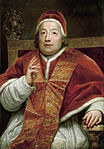Camauro


Acamauro(from theLatincamelaucumand from theGreekkamelauchion,meaning "camel-skin hat ") is a cap traditionally worn by thepope,the head of theCatholic Church.
Papal camauros are made from red wool or velvet with whiteerminetrim, and are usually worn during thewinterin place of thezucchetto.Like thebirettaworn by lower clergy and themortarboardworn byacademics,the camauro derives from theacademic cap(thepileus), originally worn to protecttonsuredclericalheads in the cold season. It is often worn with a redmozzetta.
History[edit]
The camauro has been part of the papal wardrobe since the 12th century. Until 1464, it was worn bycardinals,without theerminetrim; from that date, the camauro became exclusively a papal garment and cardinals wore the scarletbirettainstead. The papal camauro fell into disuse after the death ofJohn XXIIIin 1963. It was revived once only in December 2005 byBenedict XVI.Benedict's choice prompted media comparisons toSanta ClausandFather Christmas;[1]Saint Nicholas,who may have been the inspiration for the legend of Santa Claus, was bishop ofMyrain the early fourth century.[citation needed]
A camauro was part of the headdress of theDoge of Venice,worn under thecorno ducaleor stiff peaked cap. Every Easter Monday, the doge headed a procession fromSan Marcoto the convent ofSan Zaccariawhere the abbess presented him a newlinencamauro crafted by the nuns.[citation needed]
Notes[edit]
- ^"'Santa Pope' woos Vatican crowds ".BBC News.22 December 2005.Retrieved16 March2013.
References[edit]
- Philippi, Dieter (2009).Sammlung Philippi – Kopfbedeckungen in Glaube, Religion und Spiritualität.Leipzig: St. Benno Verlag.ISBN978-3-7462-2800-6.
External links[edit]
- About the camauro
- The Philippi Collection
- About the skull capArchived4 February 2012 at theWayback Machine
- 'Santa Pope' woos Vatican crowds(BBC News,22 December 2005))
- History of the Skullcap(PDF,p. 21–22)
- Various popes wearing the camauro on a church watching blog
- Pictures of Camauro and other clerical headgear, information and literature in German language
- Picture with summer-camauro in amaranth red silk, white camauro in silk-damask worn during the Octave of Easter and winter-camauro in red velvet




